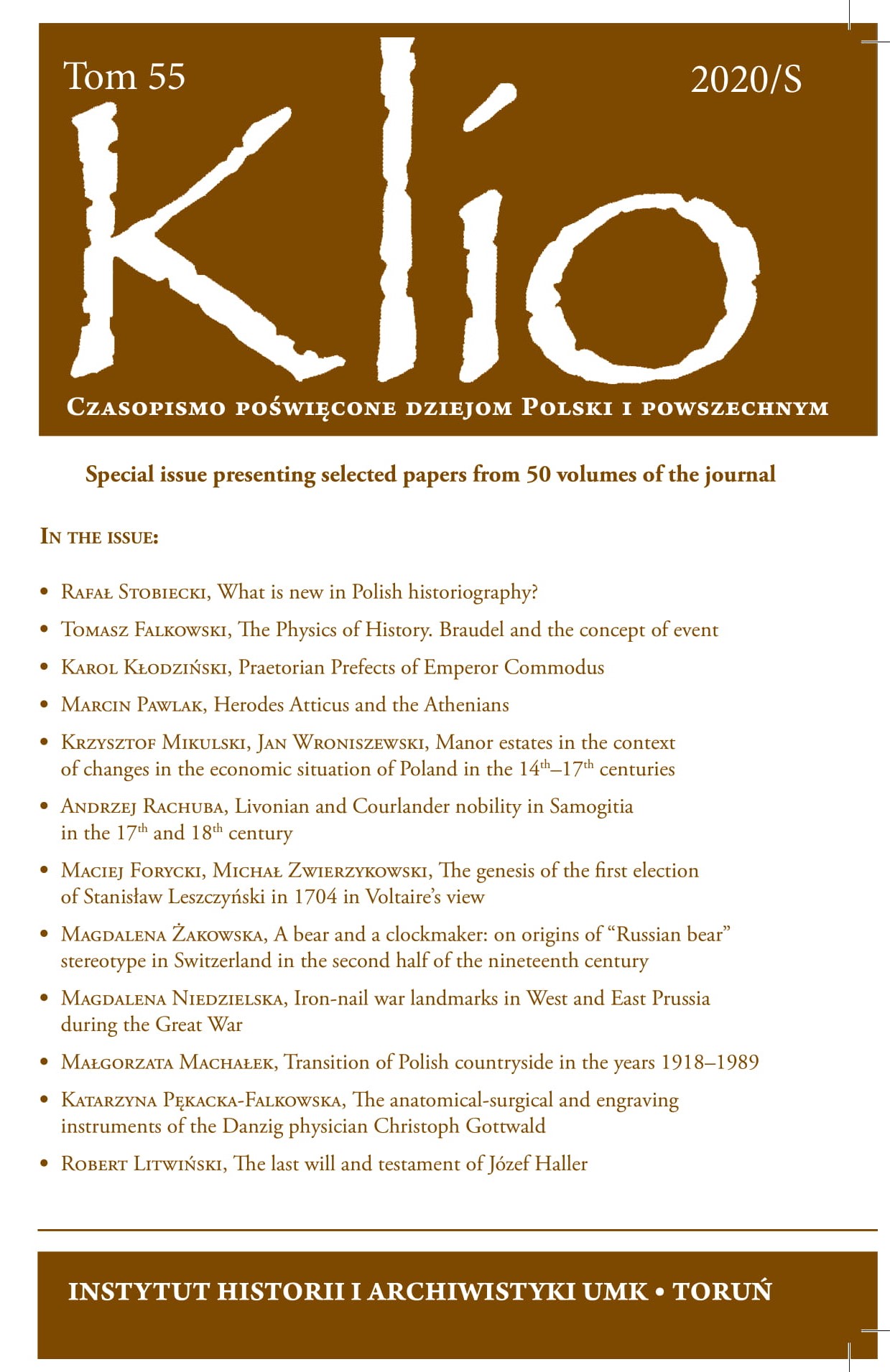A bear and a clockmaker: on origins of “Russian bear” stereotype in Switzerland in the second half of the 19th century
DOI :
https://doi.org/10.12775/KLIO.2020.041Mots-clés
social history, Russia in 19th century, press in SwitzerlandRésumé
The article analyses the specific attitudes of the ‘Russian Bear’ metaphor in the German-language Swiss press in the second half of the 19th century: in the all- European context as well as in the context of its role in building the Swiss national identity. The author has proven that there exists a connection between the Swiss image of Russia and the ‘colonial discourse’ (described by Edward Said) in that period. The article indicates the great role of the ‘bear’ metaphor within the key binary oppositions, distinctive for that discourse: West – East, culture – nature, civilization – barbarity, democracy – despotism. It analyses as well the typical Swiss way of perceiving Russia – through the prism of the ethical discourse, which had enabled the 19th century Helvetians to play the role of ‘Europe’s conscience.’ The author indicates that – while using the ‘Russian Bear’ metaphor – the 19th century Swiss press used to categorize Russia as an antithesis of the countries that personified the main attributes of the culture of the West. While making oppositions between the Russianness and the Germanness the Swiss press was building such oppositions as: order – chaos, creation – destruction, reason – irrationality, self-control – irritability. The ‘Russian Bear’ as a partner of the French Marianne used to personify an antithesis of the French refinement. The ‘Russian Bear’ metaphor compared with the symbol of Helvetia used to serve to build oppositions between the liberal, wealthy, democratic Switzerland and Russia, which was perceived as a severe ‘Eastern despothy’.
The paper was originally published as Niedźwiedź i zegarmistrz. U źródeł stereotypu „rosyjskiego niedźwiedzia” w Szwajcarii w drugiej połowie XIX w., “Klio” 2012, vol. 20 (1),
pp. 171–200, DOI: 10.12775/KLIO.2012.006.
Références
Boscovits F., Sie denkt immer nur an Revanche [Ona wciąż myśli tylko o rewanżu], „Nebelspalter” 1894, nr 14.
Brunner B., Eine kurze Geschichte der Bären, Berlin 2005, s. 86–87. 46 W. D. Storl, Der Bär. Krafttier der Schamanen und Heiler, Baden, München 2005, s. 235.
Collmer P., Die Schweiz und das Russische Reich 1848–1919. Geschichte einer europäischen Verfl echtung, Chronos Verlag, Zürich 2004.
Daly J., Russian Punishments in the European Mirror, [w:] Russia in the European Context 1789–1914. A Member of the Family, red. S. P. McCaff ray, M. Melancon, New York 2005, s. 161–188.
Images of the Other in Ethnic Caricatures of Central and Eastern Europe, ed. D. Demski, K. Baraniecka- -Olszewska, Warsaw 2010, s. 338–361.
Janion M., Niesamowita Słowiańszczyzna. Fantazmaty literatury, Kraków 2006.
Jenny H., Der Uhrmacher, „Nebelspalter” 1889, nr 12.
Malia M., Russia under Western Eyes: From the Bronze Horseman to the Lenin Mausoleum, Cambridge–London 1999.
Moser A., Land der unbegrenzten Unmöglichkeiten. Das schweizerische Russland- und Russenbild vor der Oktoberrevolution, Zürich 2006.
Narody i stereotypy, red. T. Walas, Kraków 1995.
Neumann I., Russia and the Idea of Europe: A Study in Identity and International Relations, London–New York 1996.
Said E., Orientalizm, tłum. M. Wyrwas-Wiśniewska, Poznań 2005.
Said E.W., Nationalism, colonialism and literature. Yeats and colonization, „A Field Day Pamphlet” 1988, nr 15.
Stephens F.G., E. Hawkins E., Catalogue of Prints and Drawings in the British Museum. Division I. Political and Personal Satires, vol. 3, part 1, London 1877.
Stereotypisierung des Fremden. Auswirkungen in der Kommunikation, red. O. Rösch, Berlin 2000; T. D. Nelson, Psychologia uprzedzeń, tłum. A. Nowak, Gdańsk 2003.
Stereotypy i uprzedzenia, red. M. Kofta, A. Jasińska-Kania, Warszawa 2001.
Szarota T., Niemcy i Polacy. Wzajemne postrzeganie i stereotypy, Warszawa 1996.
Wolff L., Inventing Eastern Europe: The Map of Civilization on the Mind of the Enlightenment, Stanford 1994.
Téléchargements
Publiée
Comment citer
Numéro
Rubrique
Licence
© Klio. CPDPiP 2020

Ce travail est disponible sous licence Creative Commons Attribution - Pas de Modification 4.0 International.
Stats
Number of views and downloads: 1059
Number of citations: 0



